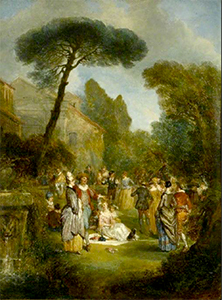
- Home Page
- Accepted
Paintings & Copies - Doubtful
Attributions - Doubtful Textual References
- Alternative
Titles - Collectors &
Museums - Bibliography
- Search Abecedario
- Watteau &
His Circle
X. L’Escarpolette
Entered June 2020
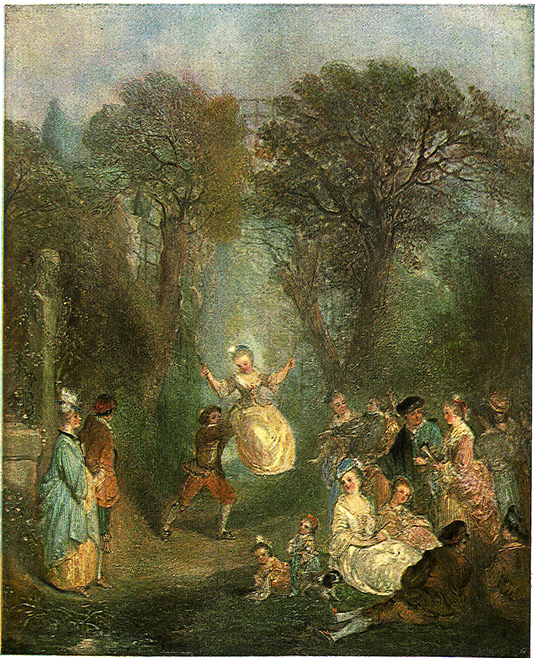
Whereabouts unknown
Oil on canvas (presumed)
Measurements unknown
PROVENANCE
Southwick Place (Hyde Park), Wales, collection of Hon. William Evans (1846/47-1918; judge).
SELECT BIBLIOGRAPHY
Wood, “Picture Collector’s Experiment” (1909), 16, 31.
Ferré, Watteau (1972), 2: cat. P 75.
REMARKS
It is hard to imagine that a century ago there were those who believed that this fête galante could be by Watteau himself. The pale colors, the weak faces with pink cheeks, and not least of all, the confused jumble of people at the right should have forewarned them that this was only a pastiche of elements derived from Watteau.
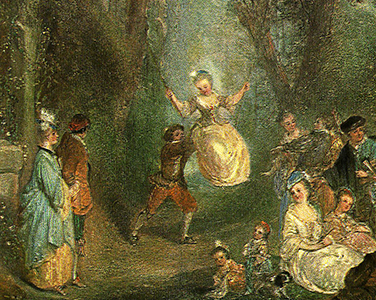
L’Escarpolette (detail).
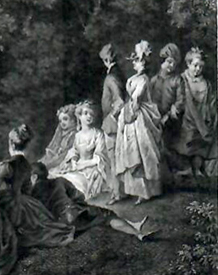
Jacques Couché after Watteau, Le Bal champêtere (detail), engraving.
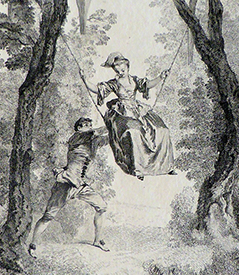
Louis Crépy after Watteau, L’Escarpolette, engraving.
The couple at the left and the woman seated on the ground, her hands folded in her lap, are taken from either Watteau’s Le Bal champêtre or La Musette, or from the engravings after these paintings. Between them is a woman on a swing, her escort pushing her forward. This demure couple, far more demure than similar couples in Pater‘s paintings, is taken from Louis Crépy’s engraving after Watteau’s arabesque, L’Escarpolette.
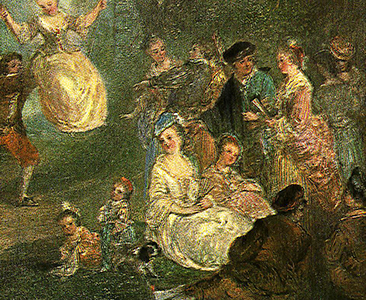
L’Escarpolette (detail).
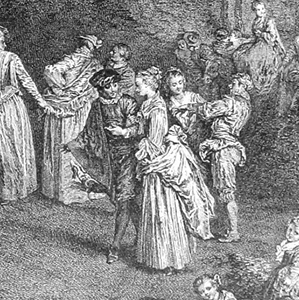
Nicolas de Larmessin after Watteau, L’Accordée de village (detail), engraving.
The gentlemen urging his female companion on and the two children standing on the other side of the woman in white can be traced to Nicolas de Larmessin’s engraving after Watteau’s L’Accordée de village.
The more one studies this pastiche, the more one realizes that this painting is a composite of elements carefully excerpted from Watteau’s paintings and re-combined to create an entirely new composition.
While this painting might seem to be just another pastiche, one that was ingeniously crafted, the work has yet another secret to reveal. It was not painted in the late eighteenth century—even though it hints at the age of Fragonard—but, instead, it is a creation of the mid-nineteenth century. It was, I believe, painted by George Henry Andrews (1816-1898), an artist who specialized in such faux-rococo scenes. Moreover, he was not a backroom forger but an artist who publicly exhibited his historicizing creations. L’Escarpolette is close in style and motifs to other paintings by him, such as a fête galante at Chequers Court. The two works are not only similar in appearance but also they share several of the same specific figures, notably the woman walking into the picture at the left, and the woman seated on the ground with her hands folded in her lap. Where they differ, it is only because Andrews borrowed figures from other well-known Watteau compositions to fill out the Chequers canvas.
At the turn of the century, when the painting was in the Evans collection, it was part of an ensemble of works that had been assembled to show the compatibility of old and contemporary art. Thus a Monticelli fête in a vast landscape was understandably compared with Watteau. But it is mystifying how they could have confused Andrews’ contemporary recreation of an old style with the old style itself.
